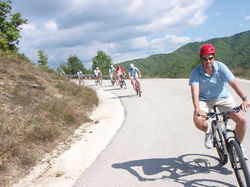
Parapente
As a kind of sport, "Parapente" emerged since the mid 80s. But it has been developed rapidly worldwide because of its ease of learning, low cost, safety and job satisfaction. Greece is particularly ideal for this particular sport, due to favorable climatic and soil conditions.

Paragliding or Parapente comes from the French name (para-by parachute and pente = slope); It makes come true an ancient human desire: the freedom of flight. It gives to anyone the opportunity to fly like a bird and assimilate magical emotions. As the Greek name describes itself, is a about a "special parachute", with which someone can take off from a slope regardless of its height (when of course weather conditions are suitable) and does not require any kind of machine.
Taking off is being proceeded from the ground and the operator may run into a hillside. The flight is done under the force of gravity, the air and the man who wields. As it is not a flight mean, from the moment of takeoff and on, is normal parapente to lose height due to gravity.
But because of its shape and construction (like an air wing), it generates levity and makes its way forward, while losing altitude. The descenting ratio (measures how much it loses weight per minute) varies depending on the category, construction, weather conditions and handler's experience. It is constructed to exploit wind currents in order to stay as long as possible in the air. By this way the flight can last from minutes to several hours, depending on circumstances and mood.
Parapente weighs from 10 to 15 kilos. It can be easily retracted in few minutes by a single person, and fits in a back bag.






















































